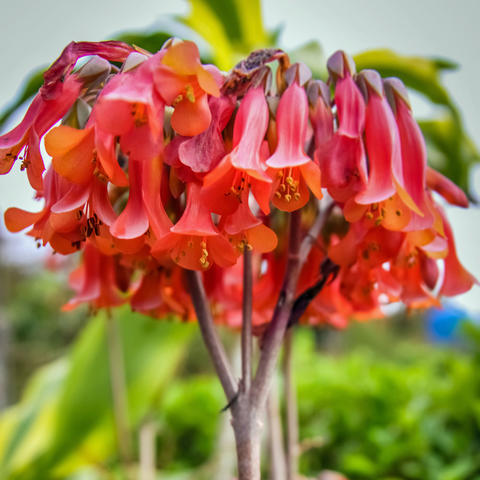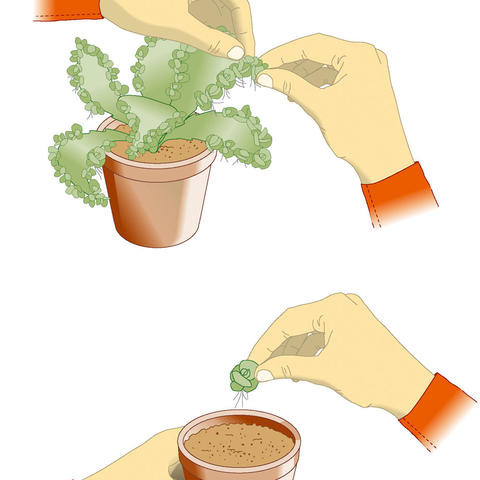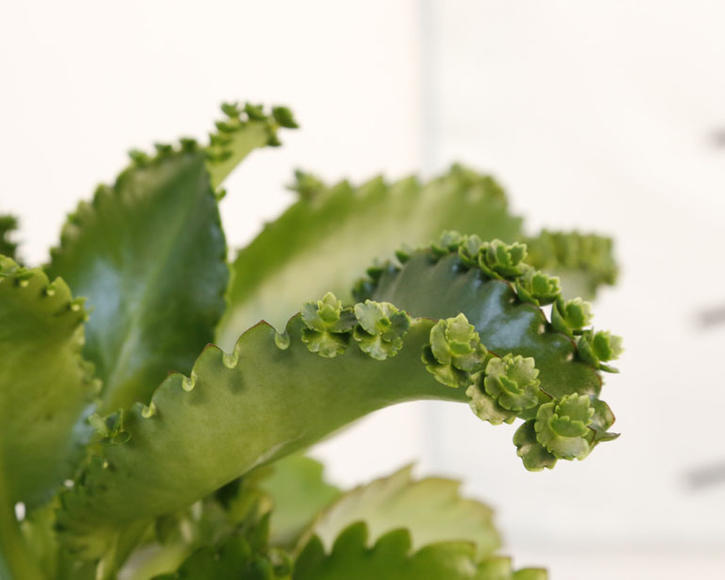Alligator plant
Hardly any other plant reproduces as efficiently as the alligator plant. You can find tips for cultivating this highly reproductive houseplant here.
Factsheet
- Growth type
-
- Succulent
- Growth height (from)
- from 30 cm to 150 cm
- Growth characteristics
-
- bizarre
- upright
- overhanging
- Kindel
- Flower color
-
- red
- Flower shape
-
- Panicules
- Uniflorous
- Bells
- Leaf color
-
- green
- page format
-
- triangular
- pointed
- Fruit shape
-
- Bellows fruit
- Light
-
- sunny
- Soil type
-
- gravelly to sandy
- Soil Moisture
-
- moderately dry
- Lime compatibility
-
- lime-loving
- Nutrient requirements
-
- moderately nutritious
- Decorative or utility value
-
- Leaf ornaments
- Use
-
- Interior greening
- Planters
- Winter garden
- Garden style
-
- Pot garden
The Alligator plant (Kalanchoe daigremontiana) belongs to the genus Kalanchoe and comes from the forests of Madagascar. In the meantime, however, the plant has grown wild in many tropical and subtropical areas. Their fleshy leaves clearly show that they belong to the thick-leaf family (Crassulaceae). Within the genus, alligator plants have their own section and are grouped under the umbrella term Bryophyllum. The plant is therefore often found under the name Bryophyllum daigremontianum. This name appears particularly frequently in anthroposophic medicine, where ingredients of the Alligator plant are used for wound healing, nerve calming and to promote fertility and pregnancy.
Kalanchoe daigremontiana is often wrongly called the "Goethe plant" " because the poet and researcher was so fascinated by the Alligator plant that in 1814 he wrote a botanical treatise on a Bryophyllum plant. His research object was not the Kalanchoe daigremontiana, but the related species Kalanchoe pinnata (formerly Bryophyllum calycinum). Kalanchoe daigremontiana was not described in detail until a hundred years later by French botanists. Since the Alligator plant is not hardy, we cultivate it as a houseplant.
The Alligator plant grows upright. In contrast to the Kalanchoe species, which are mostly also sold as indoor plants, Kalanchoe daigremontiana is relatively tall at 11.81 to 59.05 inches. Caution: The sap of the Alligator plant contains a steroid called daigremontianin, which is toxic to the heart, nerves and muscles!
The alternately arranged leaves of the Alligator plant are thick, triangular and pointed at the end. Their color varies greatly and the same plant can have all shades from simple green to purple-green. The famous leaf buds, to which the alligator plant owes its name, form in small hollows along the leaf margins (see propagation).
The flower of Kalanchoe daigremontiana appears on a tall, brown stem that grows out of the center of the plant. It consists of loosely arranged, panicle-like, bell-shaped, hanging single flowers in the colors red to purple.

After the flowering period, the Alligator plant forms four tiny, almost 0.39 inch long follicles per flower which contain the seeds.
The natural habitat of the tropical Alligator plant is very sunny. You should therefore place the plant pot in a very bright and warm place in the apartment, for example near a south-facing window. In warm summers, the plant can be placed in the sheltered terrace, as long as the night temperatures do not drop below 50 degrees Fahrenheit. Then the leaves must get slowly accustomed to the direct sun.
Since the Alligator plant grows on sandy and calcareous soil in its native habitat, it should also be potted in well-drained cactus soil as an indoor plant. Alternatively, you can use regular potting soil, half mixed with sand and pumice gravel. Make sure that the water in the pot is well drained, because the Alligator plant does not like wet feet.
Alligator plant belong to the group of succulents and require very little water. Always allow the substrate to dry well between waterings. The plant tolerates little water instead of too much. In winter, watering can be temporarily stopped completely when the temperatures are lower.
Only fertilize your Alligator plant moderately, because the vigorously growing plant requires very few nutrients. A monthly dose of cactus fertilizer over the summer months is sufficient. If you use conventional flower fertilizer, reduce the amount to one third. Too much fertilizer will harm the plant.

The best time to repot is early spring (March). Put the Alligator plant in a fresh mixture of potting soil and sand / gravel or cactus soil.
The plant should also be pruned in spring, i.e. before the Alligator plant sprouts again. Another pruning of the flower stalk is possible in midsummer. This stimulates the branching of the plant. Since the sap is poisonous, you should wear gloves when cutting! In addition, Kalanchoe daigremontiana does not need pruning.
For a lush flowering, it makes sense to overwinter the Alligator plant in a cool and bright place at around 50 degrees Fahrenheit. If the plant is warm all year round, it will turn pale and form long, thin shoots without flowers.
The Alligator plant owes its name to its special form of propagation: Bryophyllum plants form a number of fully developed spiderette along their leaf margins, which already have roots and can grow wherever they fall. The spiderette fall away from the mother plant with every touch, no matter how light. This particularly effective form of propagation is also the reason why many nurseries avoid the alligator plant - it is hardly possible to prevent the small alligator plant leaves from spreading. The apt English name of the plant is therefore also "Mother of Thousands" ".

As a potted plant, the plant's tendency to reproduce is kept within limits, but even here offsets can be found from time to time in neighboring plant pots. If you want to multiply the Alligator plant specifically, put several of the mini plants together in a pot with potting soil and let them root there. To do this, drill small holes in the soil and insert the fine roots into them. The leaf roots should only lightly touch the soil. Press the soil all around and water. The Alligator plant grows quickly in bright places above 59 degrees Fahrenheit.
Pests avoid the alligator plant as much as possible. A common mistake in care is too much watering. If the plant is too wet, it will rot from below and may even die.

